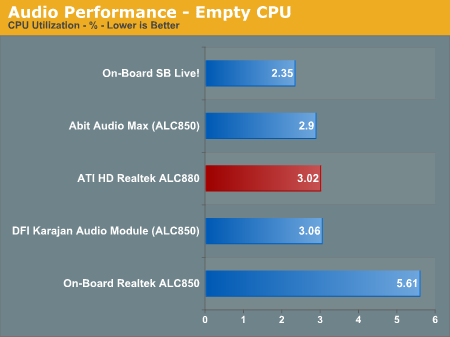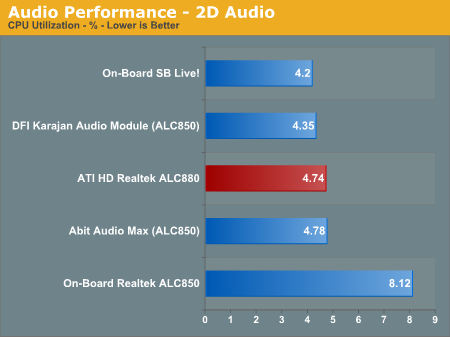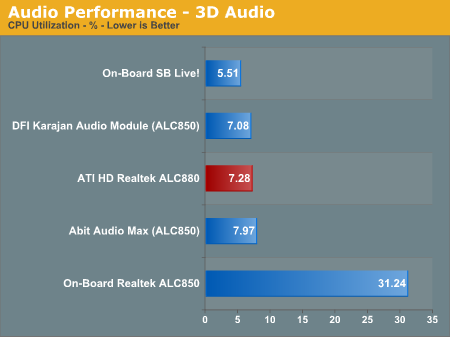Sapphire PURE Innovation - ATI's Chipset for the AMD Enthusiast
by Wesley Fink on July 29, 2005 12:05 AM EST- Posted in
- Motherboards
Audio Performance
For audio testing, we used Rightmark 3D Sound CPU utilization test, which is the same benchmark run in our earlier nForce4 SLI and Ultra roundups. This benchmark measures the overhead or CPU utilization required by a codec or hardware audio chip.



It is very important to point out that the ATI Crossfire AMD is the first Athlon 64 board to deliver Azalia High Definition audio. Those who have been complaining about the poor AC'97 audio present on most AMD boards should be very pleased to find Azalia HD on the ATI.
We did some subjective listening tests with the ATI Azalia HD through a Dolby amplifier and a 5.1 speaker setup. The ATI Azalia HD was in a completely different league from the other audio solutions that we have tested on Athlon 64. Noise was virtually nonexistent, and the imaging and depth were superb when listening to Orff's Carmina Burana. The same CD sounded thin, noisy, and artificial through a more common ALC850 fed to the same Dolby amp and 5.1 speakers. This is not to say that the Azalia HD is at the same level as the very best audio cards, but it is a lot closer than what we think many of you imagine.
As the first implementation of Azalia HD audio on A64, the HD Realtek ALC880 features:
- High-performance DACs with 100dB S/N ratio
- ADCs with S/N ratio greater than 85dB
- Meets performance requirements for audio on PC2001 systems
- 8 DAC channels support 16/20/24-bit PCM format for 7.1 audio solution
- 3 stereo ADCs support 16/20-bit PCM format, two for microphone array, one for legacy mixer recording
- Supports 44.1K/48K/96K/192kHz DAC sample rate
- All ADCs support 44.1K/48K/96K sample rate
- Applicable for 4-channel/192kHz and 6-channel/96kHz DVD-Audio solutions
- Up to four channels of microphone input are supported for AEC/BF application
- High-quality differential CD input
- Supports Power Off CD function
- Supports external PCBEEP input and built-in BEEP generator
- PCBEEP Pass-Through when link is in RESET state
- Software selectable 2.5V/3.75V VREFOUT
- Six VREFOUTs are supported by default, with additional four VREFOUTs available by sharing unused analog I/O pins
- Two GPI (General Purpose Input) jack detection pins (each designed to detect 4 jacks)
- 16/20/24-bit S/PDIF-OUT supports 44.1K/48K/96kHz sample rate
- 16/20/24-bit S/PDIF-IN supports 44.1K/48K/96kHz sample rate
- Optional EAPD (External Amplifier Power Down) supported
- Power support: Digital: 3.3V; Analog: 3.3V/5.0V
- Power management and enhanced power saving features
- Compatible with AC'97
- 48-pin LQFP package (lead-free package also available)
- Reserve analog mixer architecture for backward compatibility with AC'97
- -64dB ~ +30dB with 1dB resolution of mixer gain to achieve finer volume control
- Impedance sensing capability for each re-tasking jack
- All analog jacks are stereo input and output re-tasking for analog plug & play
- Built-in headphone amplifier for each re-tasking jack
- Supports external volume knob control
- Supports 2 GPIOs (General Purpose Input/Output) for customized applications
- Hardware de-scrambling for DVD-Audio Content protection
- Meets Microsoft WHQL/WLP 2.0 audio requirements
- EAXTM 1.0 & 2.0 compatible
- Direct Sound 3DTM compatible
- A3DTM compatible
- I3DL2 compatible
- HRTF 3D Positional Audio
- Emulation of 26 sound environments to enhance gaming experience
- 10 Software Equalizer Bands
- Voice Cancellation and Key Shifting in Karaoke mode
- Realtek Media Player
- Enhanced Configuration Panel and device sensing wizard to improve user experience
- Microphone Acoustic Echo Cancellation (AEC) and Beam Forming (BF) technology for voice application
- Mono/Stereo Microphone noise suppression
- ALC880D features Dolby® Digital Live output for consumer equipment










52 Comments
View All Comments
RobFDB - Saturday, July 30, 2005 - link
Guess you missed where i said "(with the exception of MSI)". Learn to read mate before you go posting.RobFDB - Friday, July 29, 2005 - link
ATI and Sapphire should be congratulated for bringing the AC880 to AMD users. We had it good with Soundstorm but since then onboard audio as gone back several steps (with the exception of MSI). Its good that AMD users are being given the option to have quality onboard audio.bob661 - Friday, July 29, 2005 - link
This what impresses me the most about these boards is this codec support. I still won't buy an ATI chipset until the third or fourth version comes out (you guys can test it for me) but impressive features and performance nonetheless.jab98 - Friday, July 29, 2005 - link
*codecerwos - Friday, July 29, 2005 - link
"[AMD] Enthusiast" is written with a capital E in the article, and it should not be, since it's not a proper noun. Please fix this error, because it looks grossly unprofessional to anyone with a reasonable command of the written word.RobFDB - Friday, July 29, 2005 - link
Really though, get over it. It doesnt matter in the slightest if we're being honest here. Anyway back to more important matters.I'm really happy that ATI have managed to bring a top performing board aimed at enthusiasts to market. I was also extremely impressed to see Sapphire implement 4v for the RAM. One issue that i'd like to see investigated is wether the cold boot issue that affects DFI NF4 boards using OCZ VX mem @ high voltages affects the Sapphire board too. Aside from that this is a very impressive showing from ATI. One last thing. I have a x850XT PE and i'm not sure if that can be used as a slave card when ATI bring out the R520. If so that would make a very attractive upgrade.
rjm55 - Friday, July 29, 2005 - link
The X850XT PE works fine as a slave with the X850 Master Card. In demos at Computex, ATI was showing an X850 Master with an X850XT PE slave.Jojo7 - Friday, July 29, 2005 - link
This isn't exactly true. Ati distributed a special driver that SIMULATED crossfire. The actual cards were really just 2 identical x850xtpe's. Though, one probably had an altered bios to simulate a master card.Read it for yourself: http://anandtech.com/weblog/default.aspx?bid=231">http://anandtech.com/weblog/default.aspx?bid=231
dlamblin - Friday, July 29, 2005 - link
Did I miss the mention in the article? Is this an ATX or an mATX board. I'm guessing the former, but it wouldn't be out of place to list the fact along side the rest.erwos - Friday, July 29, 2005 - link
It's ATX. If it has more than four slots, it's too big to fit the mATX standard.